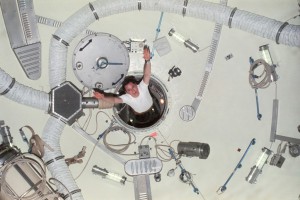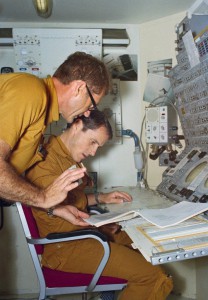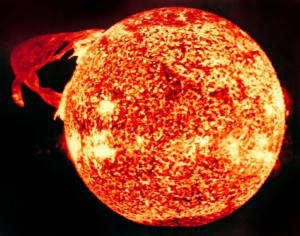 |
| NASA photo, Feb. 1974: “Scientist-astronaut Edward G. Gibson, science pilot for the Skylab 4 mission, demonstrates the effects of zero-gravity as he sails through airlock module hatch.” |
There’s another world behind the sun / He used to shine on everyone / And lately I’m amazed at the way it’s grown / It moves in at midnight when I’m all alone. – Duncan Browne, “My Only Son”
On January 21, 1974, Dr. Ed Gibson was hard at work in orbit aboard Skylab, viewing what he characterized as a “moderately active” Sun. He’d been advised what to spot by the previous mission’s science pilot. Gibson wrote in the 1979 NASA publication A New Sun, “[Skylab 3 science pilot] Owen Garriott…had suggested that when a tiny bright point appears on the extreme ultraviolet image of the Sun, it may be an early signal that a flare is beginning.”
Gibson had already logged well over eight weeks in space, and was on his way to becoming one of the world’s long-duration spaceflight champions, but one much-sought-after phenomenon eluded him during his mission: the birth of a solar flare. He hoped that by being able the view a flare from its genesis, “we could find keys to the mechanism by which the Sun releases great quantities of energy from a very small volume in a fraction of a minute.” But if he was not atthe Apollo Telescope Mount’s console at the time, or if he started its instruments too late after the flare had already begun, he’d be out of luck, and would’ve perhaps forever missed a unique opportunity.
But that day, Gibson’s eyes grew wide. He enthused, “Suddenly, a small bright point appeared right in the center of my screen. As I started the instruments taking data rapidly in their flare modes, I was elated to see the bright point blossom into a full-blown flare.” Gibson almost wanted to stop time; as a solar physicist, this was everything he had longed for.
A Watershed Time For Solar Physics
Prior to Skylab, NASA did possess solar observatories; the Orbiting Solar Observatory (OSO) program had been in effect since the 1960s, but these satellites were limited in what they could accomplish as far as power and imagery. At the time of its launch, Skylab’s Apollo Telescope Mount represented a huge “leap forward” in solar observations – it had virtually unlimited power, and some of its cameras carried film for as many as 16,000 pictures. Gibson, with his academic background and expertise, was perhaps the perfect person to helm the space station’s solar physics experiments. For the first time, a solar telescope was above the Earth – free of atmospheric interference – with an expert in its “driver’s seat.”
Why study the Sun? In October 1974’s issue of National Geographic, Gibson set out the case: “The knowledge we gain is applicable in many areas, from research into generating energy by nuclear fusion here on Earth to understanding the distant stars. Further, the stronger solar emissions affect weather, long-range radio communication, magnetic storms, auroras, perhaps even biological evolution.” To this day, predicting the Sun’s activity is key in mitigating certain phenomena (aforementioned by Gibson) here on Earth. But this technology was in its infancy in 1973-74, and Skylab’s resident solar physicist was at the forefront of advancing it.
Gibson also emphasized the massive ground support response required to undertake these then-groundbreaking observations: “More than 200 scientists and engineers monitored and helped plan daily operations of the instruments. Some 150 solar observers in 17 countries coordinated their efforts with ours, multiplying the data.” Frequently scientists and observers would relay solar findings seen on terra firma to facilities in Houston, and ultimately the information would make its way to mission control, and, lastly, the crew. The crew would then make observations in real time.
The Link From Apollo To Shuttle
Skylab 4, on many levels, was perhaps the mission to usher in the space shuttle era. The Apollo-era way of scheduling activities to the last possible minutecould not work effectively aboard shuttle missions, or future long-duration missions. In addition, the shuttle would see more civilian scientists and payload specialists fly. A different way to work would be needed, and Skylab 4 represented this transition period. This thinking led to what Gibson called “my most interesting and challenging day on Skylab.” It was January 26, just five days after he observed the birth of a solar flare.
Gibson wrote:
…Houston asked me to develop and implement most of the plans for one full day’s observations. They did this as an experiment, to see how an orbital observatory could be run on future NASA Space Shuttle missions when experimenters themselves will fly. Using the teleprinter, they sent up a general statement about the scientific goals and limitations of each experimenter and their knowledge of the state of the Sun. The rest was left to me.
I had a fascinating day, completely involved, entirely committed. Laying out the schedule was relatively straightforward. Routine data-gathering formed the framework that filled in with observations of the Sun’s most interesting features. Knowing the experiments’ objectives, the degree to which they had already been met, and the current state of the Sun, I could do all the short-term planning and make all the real-time changes in the observing program that were required. By now the matching of scientific objectives with the operation of the console had become second nature and the ATM could be played like a piano, by ear, with cumbersome sheet music put away. On the other hand, this day’s work also demonstrated the importance of an even closer link than we had between ground scientists and in-flight observers. I found that I sometimes missed the wisdom of the ground personnel in forming my decisions. Two heads are certainly better than one, especially if they can exchange knowledge freely.
A huge wealth of solar data was gleaned during Skylab’s eight months of manned operations. While its findings and images are largely superseded by data from more modern solar observatories (such as NASA’s Solar Dynamics Observatory), it still stands – and will most likely remain – the most ambitious, human-helmed suite of solar physics experiments ever flown in space. Gibson deserves the final words, as written in Nat Geo: “Skylab marshaled in the largest single effort to observe the Sun in the history of man.”
Sources:
- Canby, T.Y. (1974, October). Skylab, Outpost on the Frontier of Space. National Geographic, 146(4), 441-469.
- Eddy, J.A. (1979.) A New Sun: The Solar Results From Skylab. Washington, D.C.: NASA, Scientific and Technical Information Branch.
Emily Carney is a writer, space enthusiast, and creator of the This Space Available space blog, published since 2010. In January 2019, Emily’s This Space Available blog was incorporated into the National Space Society’s blog. The content of Emily’s blog can be accessed via the This Space Available blog category.
Note: The views expressed in This Space Available are those of the author and should not be considered as representing the positions or views of the National Space Society.




















